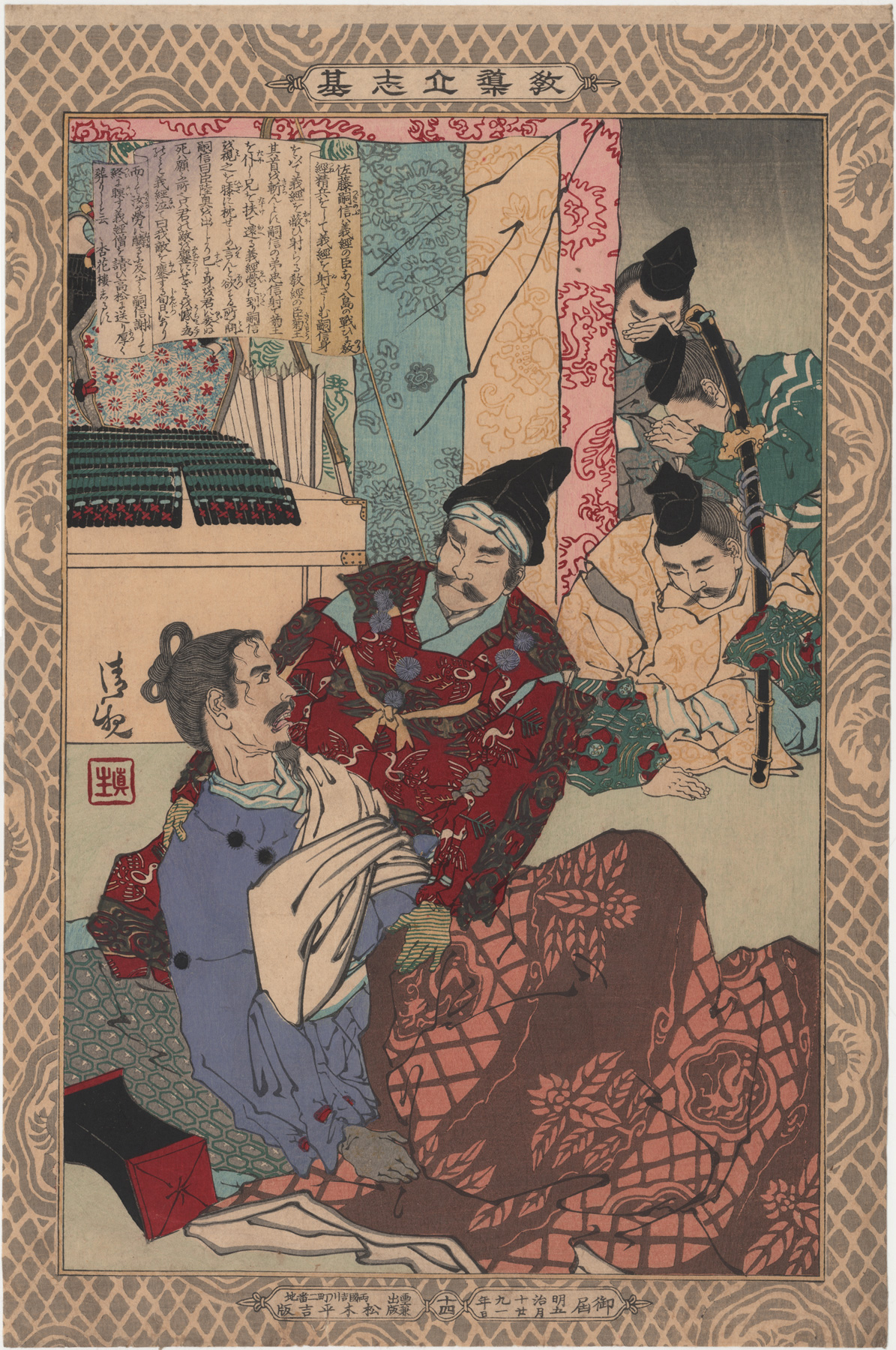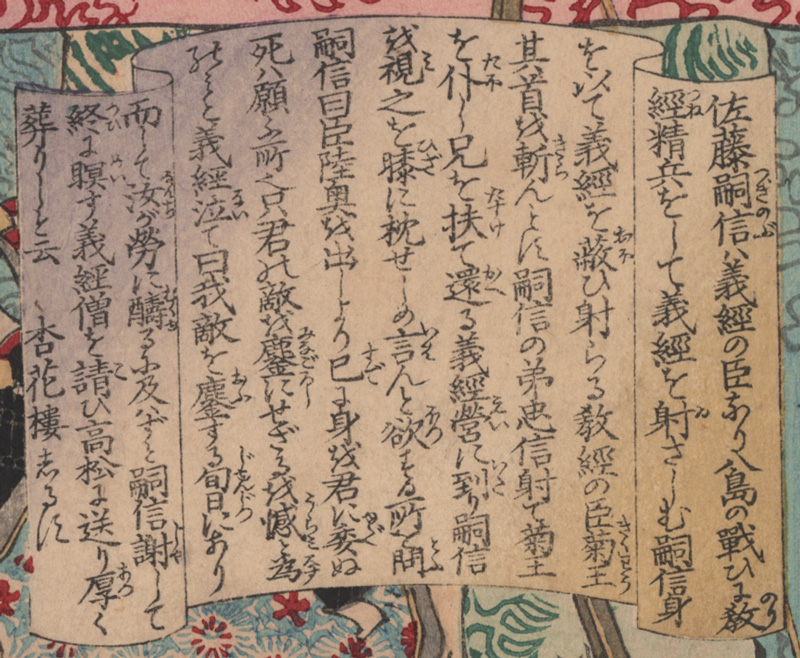About This Print
Print number 十四 (14)1 in the series Instructive Models of Lofty Ambition picturing Sato Tsuginobu on his deathbed in the arms of his lord Minamoto no Yoshitsune, for whom he sacrificed his life.Kiyochika contributed 20 prints to this series. As Smith states: "The style of Kiyochika’s offerings toInstructive Models of Lofty Ambition was decorous and even stiff, as befitted the didactic emphasis of the whole [series.]"2
1 Numbering of the prints was haphazard during the production of the series. Print numbers were sometimes inadvertently omitted; some prints in the series were never assigned numbers and a few of the same numbers appear on different prints.
2 Kiyochika Artist of Meiji Japan, Henry D. Smith II, Santa Barbara Museum of Art, 1988, p. 74.
The Death of Satō Tsuginobu
The Death of Satō Tsuginobu
The death of Satō Tsuginobu is told in the Heike Monogatari, an epic work that chronicles the Genpei War 源平合戦 (1180-1185), a conflict between the Taira and Minamoto clans during the late-Heian period of Japan which resulted in the fall of the Taira and the establishment of the Kamakura shogunate under Minamoto Yoritomo in 11921.
Felled by an arrow while shielding his lord Minamoto no Yoshitsune, Tsuginobu is carried to the rear where he dies holding Yoshitsune's hand. As recorded in the Heike Monogatari, his last words are
I regret that I must die without seeing my lord rise to fame in the world. Apart from that, he who wields bow and arrow must expect to meet his end before an enemy's shaft. It is an honor for this existence and memory for the next that the war tales of future generations will record that 'In the war between the Minamoto and Taira, Satō no Saturōbyōe Tsuginobu gave his life for his lord on the beach at Yashima in Sanuki province.2
1 wikipedia http://en.wikipedia.org/wiki/Genpei_War
2 Warriors of Japan as Portrayed in the War Tales, Paul Varley, University of Hawaii Press, 1994, p. 138-139.
Source: with thanks to Yajifun http://yajifun.tumblr.com/
4 Satō Tsuginobu (Tsugunobu) 佐藤嗣信
教導立志基 十四 佐藤嗣信 小林清親 1886年5月21日
Transcription: [scroll text by 杏花樓しるす]
“佐藤嗣信(つぎのぶ)ハ義經の臣なり 八島の戰ひに教經精兵をして義經を射さしむ 嗣信身を以て義經を蔽(おほ)ひ射らる 教經の臣菊王其首を斬んとす 嗣信の弟忠信射て菊王を仆し兄を扶(たすけ)て還る 義經榮に到り嗣信を視 之を膝に枕せしめ言んと欲する所を問 嗣信曰 臣陸奥を出しより已に身を君に委ぬ 死ハ願ふ所也 只君の敵を鏖(みなごろし)にせざるを憾と為のミ と 義經泣て曰 我敵を鏖する旬日にあり 而して汝が勞に醻(むくふ)るに及バず と 嗣信謝して終に瞑す 義經僧を請ひ高松に送り厚く葬りしと云 杏花樓しるす”
About The Series "Kyōdō risshi no motoi"
Notes:1. This series is variously translated as "Instructive Models of Lofty Ambition," "Foundations of Learning and Achievement," "Foundation of Instruction and Perseverance," "Self-Made Men Worthy of Emulation," "Paragons of Instruction and Success," "Moral of Success," "Examples of Self-Made Leaders," and "Instruction in the Fundamentals of Success." The title in Japanese is sometimes seen as "Kyōdō risshiki or "Kyōdō risshi no moto," in addition to the most commonly seen transliteration of "Kyōdō risshi no motoi".
2. For a complete listing of all the prints in the series and additional information please see the article on this site titled Instructive Models of Lofty Ambition.
This series ran between October 1885 and November 1890 and featured a long list of heroes and heroines, from antiquity to contemporary times, who were regarded as standards of moral leadership and self-realization.
Source: Kiyochika Artist of Meiji Japan, Henry D. Smith II, Santa Barbara Museum of Art, 1988, p. 74-75; original research and as footnoted.
This series of 58 prints,1 plus a table of contents sheet (目録), were originally published between October 1885 and November 1890 by the Tokyo publisher Matsuki Heikichi 松木平吉.2 The table of contents sheet issued by the publisher states that "fifty prints make up the complete set (五十番揃)". Three prints not in the initial release were added over the five year publication period, as were five redesigns of original prints, eventually increasing the total print count to 58. The seven artists contributing prints were Kobayashi Kiyochika (1847-1915) [20 prints], Mizuno Toshikata (1866-1908) [16 prints], Inoue Tankei (Yasuji) (1864-1889) [13 prints], Taiso (Tsukioka) Yoshitoshi (1839-1892) [5 prints], Yōshū Chikanobu (1838-1912) [2 prints], Toyohara Kunichika (1835–1900) [1 print], and Hachisuka (Utagawa) Kuniaki II (1835-1888) [1 print]. All the artists, with the exception of Yōshū Chikanobu, are listed in the top scroll of the table of contents sheet. Various colors (including blue, blue/green, and tan/brown) were used for the decorative border, and in 1902 the series was re-issued by Matsuki without borders.
This series of 58 prints,1 plus a table of contents sheet (目録), were originally published between October 1885 and November 1890 by the Tokyo publisher Matsuki Heikichi 松木平吉.2 The table of contents sheet issued by the publisher states that "fifty prints make up the complete set (五十番揃)". Three prints not in the initial release were added over the five year publication period, as were five redesigns of original prints, eventually increasing the total print count to 58. The seven artists contributing prints were Kobayashi Kiyochika (1847-1915) [20 prints], Mizuno Toshikata (1866-1908) [16 prints], Inoue Tankei (Yasuji) (1864-1889) [13 prints], Taiso (Tsukioka) Yoshitoshi (1839-1892) [5 prints], Yōshū Chikanobu (1838-1912) [2 prints], Toyohara Kunichika (1835–1900) [1 print], and Hachisuka (Utagawa) Kuniaki II (1835-1888) [1 print]. All the artists, with the exception of Yōshū Chikanobu, are listed in the top scroll of the table of contents sheet. Various colors (including blue, blue/green, and tan/brown) were used for the decorative border, and in 1902 the series was re-issued by Matsuki without borders.
Brief texts contained within a scroll-like cartouche appearing on each print provide historical details. The scroll composer's name is given at the end of the scroll text. The “lofty ambition” of the title is a Confucian concept, originally from Mencius, meaning “righteous determination that would inspire others.” The market for the series probably included former samurai, ambitious youth, and conservative intellectuals.
"[W]hen it was completed in 1890 the publisher was singled out for special recognition by the government for having sponsored such noble subject matter."3
1 The Tokyo Metropolitan Library online collection shows 50 prints and a Table of Contents sheet. The Table of Contents lists the titles of 50 prints. Smith in Kiyochika Artist of Meiji Japan identified 52 prints. I have identified 58 prints from this series including five prints (Ikina, Michizane Sugiwara, Kesa Gozen, Soga Brothers and Hokiichi Hanawa) that were re-designed and re-printed, likely due to damaged or lost blocks.
2 Robert Schaap notes in Appendix II, p. 166 of Yoshitoshi, Masterpieces from the Ed Freis Collection, Chris Uhlenbeck and Amy Reigle Newland, Hotei Publishing, 2011 that the series originally appeared as newspaper supplements.
3 The World of the Meiji Print: Impressions of a New Civilization, Julia Meech-Pekarik, Weatherhill, 1986, p. 122.
Print Details
| IHL Catalog | #1300 |
| Title or Description | Satō Tsuginobu 佐藤嗣信 |
| Series | “Instructive Models of Lofty Ambition” (Kyodo risshiki 教導立志基) [note: series title also listed as 'Kyodo Risshi no Moto', ‘Kyodo risshi no motoi’, ‘Kyōdō risshi ki’ and variously translated as “Moral of success” or “Foundations of learning and achievement” or “Self-made Men Worthy of Emulation”' or “Examples of Self-made Leaders” or "Paragons of instruction and success"] |
| Artist | Kiyochika Kobayashi (1847-1915) |
| Signature |  |
| Seal | shinsei 真生, as shown above |
| Publication Date | May 21, 1886 明治十九年 五月 廿ー日 |
| Publisher | Matsuki Heikichi (松木平吉) proprietor of Daikokuya Heikichi [Marks: seal not shown; pub. ref. 029] click to enlarge (from right to left) publishing and printing date: 御届 明治 十九年 五月 廿ー日 [notification delivered, Meiji 19th year, 5th month, 21st day] assigned number within series: 十四 (14) publisher information: 画工兼 出板 両国吉川町二番地 松木平吉 版 [artist and publisher Ryōgoku Yoshikawachō 2-banchi Matsuki Heikichi han] |
| Carver | |
| Impression | excellent |
| Colors | excellent |
| Condition | good - full size; not backed |
| Genre | ukiyo-e; rishki-e; kyōiku nishiki-e |
| Miscellaneous | print number 14 (十四); position 14 in the Table of Contents for the series |
| Format | vertical oban |
| H x W Paper | 14 1/2 x 9 1/2 in. (36.8 x 24.1 cm) |
| H x W Image | 12 9/16 x 8 3/16 in. (31.9 x 20.8 cm) area inside brocade border |
| Literature | |
| Collections This Print | Tokyo Metropolitan Library 280-K20 (with tan-colored border); Edo-Tokyo Museum 96200375 (with green/blue-colored border.) |



